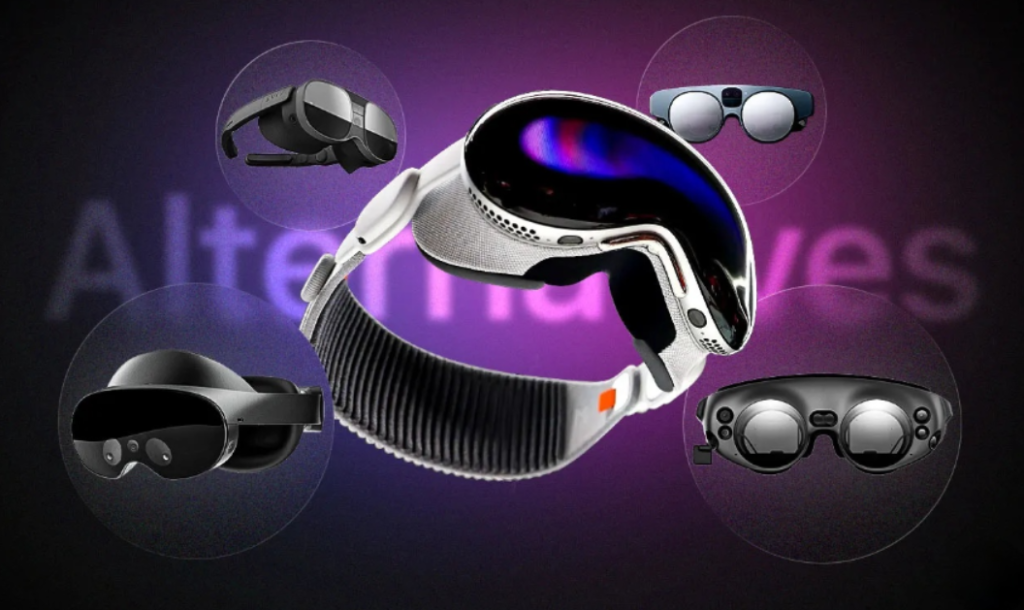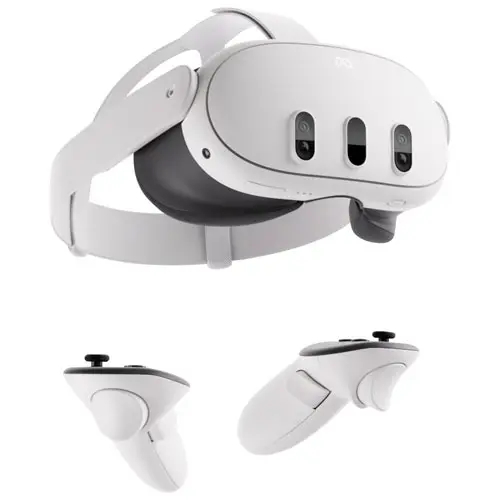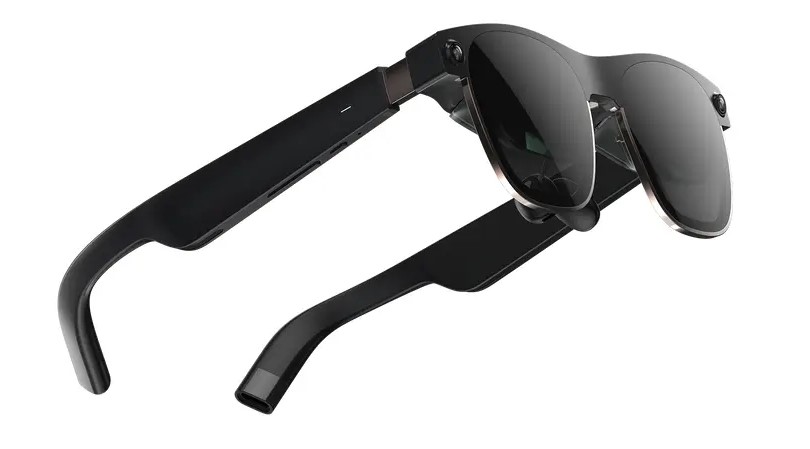
The Apple Vision Pro made a significant impact in the tech world with its spatial computing features, but its hefty price tag of $3,499 might make you think twice. If you’re looking for more affordable alternatives that still offer commendable features, there are several options available. Whether you’re not keen on investing in the Apple ecosystem or simply want a more budget-friendly choice, here are some alternatives worth considering.
Note: To ensure a fair comparison, we have only included standalone AR/VR headsets in this list. This excludes devices like PlayStation VR and Valve Index, which require additional hardware to function.
1. Meta Quest 3
In the relatively modest mixed reality headset market, the Meta Quest 3 stands out as a budget-friendly alternative to the Apple Vision Pro. The most compelling reason is undoubtedly its significantly lower price. Priced at just $500, the Meta Quest 3 is a whopping seven times cheaper than the Vision Pro!
Beyond its affordability, the Meta Quest 3 offers impressive performance and features. It is powered by the Snapdragon XR2 Gen 2, which is based on Qualcomm’s Snapdragon 8 Gen 2 SoC, ensuring top-of-the-line performance. Additionally, the Quest 3 features a full-color passthrough, adding to its appeal.

While the Meta Quest 3 may not match the design quality and hardware sophistication of the Vision Pro, it offers remarkable value for its price point. Especially for VR gaming enthusiasts, the Quest 3 shines with its inclusion of dual controllers, providing a more immersive gaming experience.
Comparatively, the Vision Pro’s heavy external battery pack adds inconvenience, whereas the Quest 3 simplifies things with straightforward charging. Additionally, the absence of native YouTube and Netflix apps on the Vision Pro is a drawback, a gap that the Quest 3 fills with its inclusion of these popular platforms. Despite this, the Vision Pro has seen the development of some compelling apps, adding to its appeal. Ultimately, the Quest 3 emerges not only as an excellent VR gaming headset but also as a versatile entertainment companion.
Price: Starts at $499.99
2. Meta Quest Pro
While the Meta Quest 3 offers impressive hardware at a more affordable price point, there are compelling reasons to consider its counterpart, the Meta Quest Pro. Despite cost-cutting measures to achieve affordability, the Quest 3 lacks features like eye and face tracking, which are present in the Quest Pro thanks to its advanced cameras and sensors.

Additionally, the Quest Pro offers double the storage capacity at 256GB compared to the Quest 3, along with 12GB of RAM instead of 8GB. Despite being heavier at 722 grams, the Quest Pro provides excellent weight distribution, which is ideal for extended use. Its impeccable design and fit make it a comfortable option for longer gaming sessions, setting it apart from the 600-650 grams Apple Vision Pro.
Additionally, the Quest Pro’s dual controllers offer solid tracking capabilities, contributing to a premium user experience. While the Quest Pro comes at a higher price point, it delivers on its promise of premium features and design, positioning itself as a compelling alternative to the Apple Vision Pro. Considering these factors, the Quest Pro emerges as a more refined and premium offering compared to the Quest 3.
Price: $999.99
3. HTC Vive XR Elite
When it comes to premium VR headsets, the HTC Vive XR Elite stands out as an excellent alternative to the Apple Vision Pro. One of its key strengths is its expansive 110-degree field of view (FOV), which enhances immersion in virtual environments.
Despite weighing 625 grams, the Vive XR Elite boasts exceptional weight distribution, thanks to its rear-mounted battery pack. This design choice ensures that the headset remains comfortable even during prolonged use, a notable advantage over the front-heavy Apple Vision Pro.

Powered by the Snapdragon XR2 Gen 1 chipset, the Vive XR Elite delivers impressive performance, supported by 12GB of RAM and a minimum of 128GB of internal storage. This setup ensures smooth operation and ample storage for VR applications and content.
Priced $2000 lower than the Vision Pro, the Vive XR Elite offers a comparable experience without compromising on features. It includes 6 degrees of freedom (6DoF) inside-out tracking, similar battery life of around 2 hours, and the added benefit of dual controllers for enhanced gaming versatility. Overall, the Vive XR Elite is a compelling alternative to the Apple Vision Pro, providing a premium VR experience at a more accessible price point.
Price: $1,499
4. XREAL Air 2 Ultra
The XREAL Air 2 Ultra offers a stylish and lightweight alternative to traditional headsets, such as the Apple Vision Pro. These AR glasses feature Sony’s micro-OLED display technology, providing a crisp 120Hz refresh rate. Despite their compact size, they offer a commendable 52-degree field of view (FOV), enhancing the immersive experience.
Weighing in at just 80 grams, the XREAL Air 2 Ultra is exceptionally comfortable to wear, akin to a pair of sunglasses. The device operates without the need for additional controllers, external processors, or battery packs, relying solely on hand gestures, eye movements, and voice commands for control. The titanium frame adds a premium touch and ensures durability, making it a practical and stylish choice for AR enthusiasts.

The XREAL Air 2 Ultra is equipped with six-degree-of-freedom hand and spatial tracking technology, along with face tracking capabilities. These features enable the Air 2 Ultra to interact intelligently with its surroundings, providing a seamless augmented reality experience.
In addition to its advanced tracking capabilities, the XREAL Air 2 Ultra offers versatile connectivity options. It can connect to a wide range of devices, including Android and iOS smartphones, as well as Windows and Mac computers. This makes it one of the most versatile and compelling AR-based alternatives to the Apple Vision Pro.
Price: $699
5. Magic Leap 2
If budget isn’t a concern, then the Magic Leap 2 should undoubtedly be your entry into the realm of AR/VR headsets. Running on the Android Open Source Project (AOSP) OS, the Leap 2 boasts cutting-edge AR technology.
One of its standout features compared to the Apple Vision Pro is its weight. While the Vision Pro tips the scales at a hefty 600-650 grams, the Magic Leap 2 is remarkably lightweight at just 260 grams. This makes it even lighter than the Vision Pro’s external battery pack, which weighs 353 grams. Such featherlight design translates into unparalleled comfort during extended wear.

Moreover, its form factor and weight distribution make it a joy to wear. The Magic Leap 2 also boasts some intriguing features, such as segmented dimming, which allows it to function as sunglasses and keep specific objects in focus.
While the Magic Leap 2 may not match the micro-OLED displays of the Vision Pro, it does offer a faster refresh rate of up to 120Hz compared to the Vision Pro’s limit of 100Hz. Additionally, the Magic Leap 2 is powered by a custom 7nm AMD Zen 2 CPU, which is the same architecture used in the Steam Deck’s custom CPU. This suggests that the Leap 2 could deliver impressive processing power, making it a strong competitor in terms of performance.
If you’re looking for a premium alternative to the Apple Vision Pro without entering the Apple ecosystem, the Magic Leap 2 is a compelling choice!
Price: $3,499
To be frank, any option from this list could serve you well. The key advantage across all these alternatives lies in their versatile connectivity. Unlike the Apple Vision Pro, which stands alone and boasts the impressive M2 and R1 chip, even ordering it online necessitates an iPhone or iPad with Face ID.
It’s understandable that those deeply entrenched in the Apple ecosystem might lean towards the Vision Pro, particularly if they have the budget for it.
On the flip side, the Vision Pro alternatives highlighted here offer excellent connectivity, working seamlessly with various devices. Plus, they come at a more affordable price point, with the Magic Leap 2 being the sole exception.
We’d love to hear your thoughts in the comments on which alternative you believe is the best substitute for the Vision Pro.




